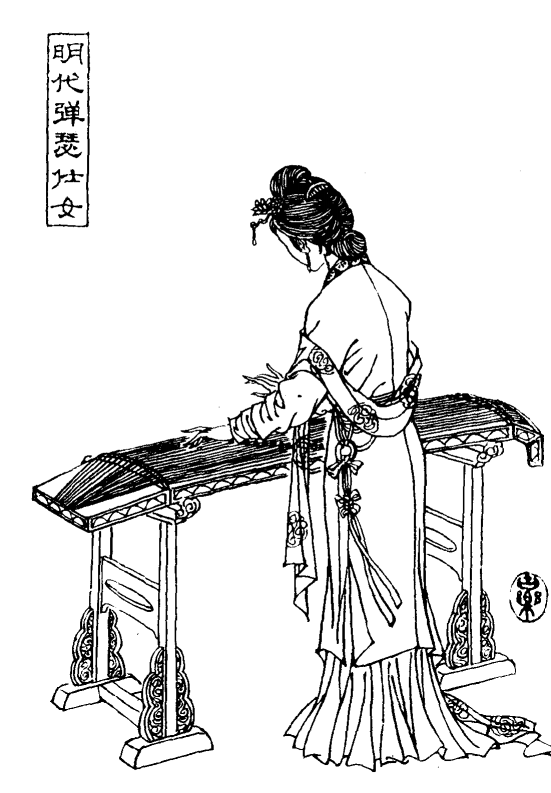Se's shape structure
1013 views · Organized by 天井 on 2022-02-15
The ancient serpent was carved from a single piece of wood, while the serpent made in the Qing Dynasty has been glued into a rectangular resonance box from the panel, the bottom plate and the frame plate. The strings are made of silk strings. On the first Yueshan (Shouyue) and the end Yueshan (weiyue), each string has a goose column that can move left and right to adjust the length of the string and determine the pitch.
Since the 1930s, our country has successively produced nearly 20 tombs in the Chu and Han tombs such as Changsha, Xinyang and Jiangling, most of which have the same shape and are consistent with the records of the pre-Qin and Han dynasties (very few are 23 or 24 string). The strings are divided into three groups, the middle group of seven strings, and the inner and outer groups of nine strings each.
From Mawangdui No. 1 Han tomb unearthed in the early Western Han Dynasty, it can be seen that the thickness of the strings is divided into two groups, the outer nine strings are a group (the diameter of the outer string decreases from 1.2 to 0.6 mm), and the middle seventh string is divided into two groups. The string and the inner nine strings are another group (the diameter of the string decreases from 1.9 to 0.5 mm from the inside to the outside).
Se is generally tuned according to the pentatonic scale, and the heptatonic scale is obtained by pressing the strings to raise a semitone.
Seers are usually divided into two types according to their length and number of chords. The big selves are 180-190 cm long and have 25 strings; the small selves are about 120 cm long and have 16 strings. In the collection of the Institute of Chinese Music in Beijing, there is an exquisite Daser made in the early Qing Dynasty (17th century), which is 209 cm long.
Since the 1930s, our country has successively produced nearly 20 tombs in the Chu and Han tombs such as Changsha, Xinyang and Jiangling, most of which have the same shape and are consistent with the records of the pre-Qin and Han dynasties (very few are 23 or 24 string). The strings are divided into three groups, the middle group of seven strings, and the inner and outer groups of nine strings each.
From Mawangdui No. 1 Han tomb unearthed in the early Western Han Dynasty, it can be seen that the thickness of the strings is divided into two groups, the outer nine strings are a group (the diameter of the outer string decreases from 1.2 to 0.6 mm), and the middle seventh string is divided into two groups. The string and the inner nine strings are another group (the diameter of the string decreases from 1.9 to 0.5 mm from the inside to the outside).
Se is generally tuned according to the pentatonic scale, and the heptatonic scale is obtained by pressing the strings to raise a semitone.

Seers are usually divided into two types according to their length and number of chords. The big selves are 180-190 cm long and have 25 strings; the small selves are about 120 cm long and have 16 strings. In the collection of the Institute of Chinese Music in Beijing, there is an exquisite Daser made in the early Qing Dynasty (17th century), which is 209 cm long.
Involving musical instruments
Se (pinyin: sè), a traditional plucked stringed instrument, is similar in shape to a zheng but slightly wider. Tuned according to the pentatonic mode, it is often used as an accompaniment instrument for the qin, and is often called the qinse together with the guqin. Se has an important position in Chinese culture and is often referred to as the guqin.
Guess you like
Organized by 棠舟 on 2022-04-22
One end of the qin is big and the other is small. The strings are drawn out from the thin end and radiate to the other end in a diverging shape. The surface of the qin is curved and the bottom of the qin is flat; the zither is a standard rectangle, and the distribution of the strings is parallel. The number of strings on the qin and the zither is also different, and the qin is generally 7 strings. The strings of the se are generally more, the ancient is 50 strings, and now it is mostly 25 strings.
read >>
Organized by 向日葵 on 2022-02-15
In Jiangling Chu tombs, there is often a serpent made of whole wood. The middle part is higher than the two side panels, and the two sides are slightly wider. A groove is dug at each end of the bottom plate, there is no resonance box, and some serge bottoms have a rectangular groove dug in the middle to disperse sound.
read >>
 渝公网安备 50010702504639号
渝公网安备 50010702504639号